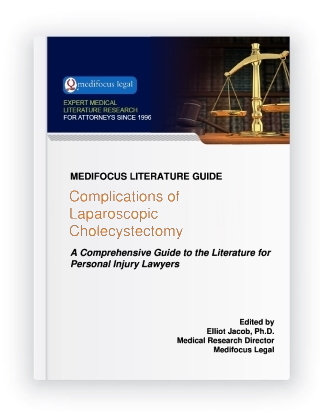Complications of Laparoscopic CholecystectomyA Comprehensive Guide to the Literature for Personal Injury Lawyers
Publisher: Medifocus Legal
Publication Date: August 26, 2019
Number of Pages: 116
A Comprehensive Guide to the Literature for Personal Injury Lawyers
Publisher: Medifocus LegalPublication Date: August 26, 2019
Number of Pages: 116
It has been estimated that about 20 million people in the United States have gallstones and over 300,000 laparoscopic cholecystectomies are performed in the U.S. each year. The wider acceptance and popularity of laparoscopic cholecystectomy in recent years has been accompanied with a broader spectrum of complications that are associated with this procedure. Whereas some of these complications are minor and can be managed conservatively, major (life threatening) complications, such as injuries to large blood vessels or an injury to the common bile duct, may necessitate conversion to an open surgical approach in order to prevent a potentially catastrophic outcome.
In general, complications of laparoscopic cholecystectomy may be grouped into those that occur during the procedure (intraoperative complications)and those that develop after the procedure (postoperative complications). In a retrospective study published in 2016 involving 740 patients who had undergone a laparoscopic cholecystectomy, the rate of intraoperative complications was 13.1% and the rate of postoperative complications was 9.5%. The most common intraoperative complications were iatrogenic perforations of the gallbladder, bleeding from tissue adjacent to the gallbladder,and spilled gallstones. The most frequently observed postoperative complications were bleeding from the abdominal cavity, bile leaks, and surgical wound infections. Less frequent complications included injury to the common bile duct, bleeding from the port, liver, or cystic artery, incisional hernias, and abdominal wall hematomas. The risk of injuries during laparoscopic cholecystectomy can be significantly reduced by precise operative technique, clear visualization of operative landmarks, and careful dissection of tissue.
The MediFocus Literature Guide to Complications of Laparoscopic Cholecystectomy is a comprehensive Guide to the medical literature for personal injury attorneys who may represent clients who have sustained an intraoperative or postoperative complication associated with a laparoscopic cholecytectomy procedure. This unique Literature Guide includes over 190 hand-selected references to articles published in peer-reviewed journals with links to the abstracts of the articles. The articles included in the Guide focus on the entire spectrum of complications of laparoscopic cholecystectomy that have been published over the past decade. The Guide also includes several journal article references to the prevention of bile duct injuries and the risk factors for conversion of a laparoscopic cholecystecomy to open surgery. The Guide promises to be a valuable addition to the library of personal injury attorneys and law firm involved in litigating cases related to complications of laparoscopic cholecystectomy
 |
- A comprehensive bibliography of 193 journal article references indexed in MEDLINE published in well respected medical and scientific journals.
- Online access to the abstracts (summaries) of the articles.
- A unique "Author Directory" consisting of the names and institutional affiliations of experts who have published and have specialized knowledge about Complications of Laparoscopic Cholecystectomy. The "Author Directory" is a valuable resource for quickly identifying and locating experts for case reviews, opinions, and testimony.
Select examples of topics that are covered by the articles referenced in this Guidebook include:
- Safe laparoscopic cholecystectomy: A systematic review of bile duct injury prevention
- Clinical Impact of Iatrogenic Small Bowel Perforation Secondary to Laparoscopic Cholecystectomy
- Gallbladder Nonvisualization in Cholecystectomy: A Factor for Conversion.
- Diminished Survival in Patients with Bile Leak and Ductal Injury: Management Strategy and Outcomes.
- Quality of Life and Medico-Legal Implications Following Iatrogenic Bile Duct Injuries.
- How often do surgeons obtain the critical view of safety during laparoscopic cholecystectomy?
- Risk Factors for Conversion of Laparoscopic Cholecystectomy to Open Surgery.
- Bile duct injuries after laparoscopic cholecystectomy: 11-year experience in a tertiary center
- Consequences of Lost Gallstones During Laparoscopic Cholecystectomy
- Early laparoscopic cholecystectomy is superior to delayed acute cholecystitis: a meta-analysis of case-control studies.
- SAGES expert Delphi consensus: critical factors for safe surgical practice in laparoscopic cholecystectomy.
- Role of routine intraoperative cholangiography during laparoscopic cholecystectomy.
- Timing of laparoscopic cholecystectomy for mild and moderate acute cholecystitis.
- Spilled gallstones during laparoscopic cholecystectomy.
- Technical aspects of cholecystectomy.
- Low-pressure versus standard-pressure pneumoperitoneum for laparoscopic cholecystectomy
- Impact of obesity and associated diseases on outcome after laparoscopic cholecystectomy.
- Prevention and treatment of bile duct injuries during laparoscopic cholecystectomy.
- Complications of laparoscopic cholecystectomy and its prevention: a review and experience of 400 cases.
- Mechanical and preventable factors of bile duct injuries during laparoscopic cholecystectomy.
is available in two formats: | |
Order by Phone:To order by phone, please call: Order by Mail:To order by mail, please print and complete this Order Form | |

